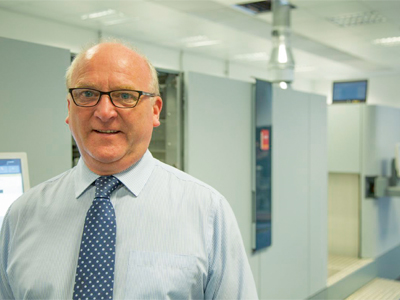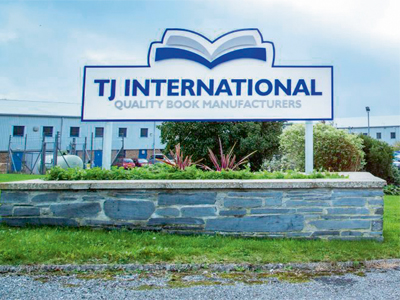Book printer TJ International was a big spender in 2014, with its first colour inkjet press and a brand new Kolbus line going in. Andy Knaggs visited the Cornwall company to talk about its evolving business.
The book market in its entirety has been in a state of considerable flux for a number of years. There has been the rise of the e-book, the self-publishing phenomenon, the prediction of the death of the printed book, and the resurgence of print amidst new publishing models brought about by innovations in digital and digital printing technology.
For book printers like TJ international, whose heritage is in litho printing, the evolving market has imposed particular demands. One has been that it must invest in new technology, and in any case this has always been a priority for the Padstow, Cornwall company. The demands go beyond just printing with the latest press though.
‘We have always been quite innovative, and have always upgraded our equipment on a regular basis,’ Angus Clark, TJ International’s managing director, told Digital Printer. ‘We have established ourselves as a reliable and credible supplier. When we say you are going to get it, you will get it. We are innovative, we invest, and we offer a full range of services in-house. We are much more flexible now than we have been. I think the market dictates that now.’
A manifestation of TJ’s commitment to investment has been its recent installation of a new continuous feed inkjet press – the Océ ColorStream 3900 from Canon – which is its first foray into short run digital colour production. The press has been running live since November, inline with Hunkeler winding/unwinding, cutting, plow folding, stacking and gluing equipment. ‘We needed to do a glued book block at speed and that’s what it does,’ explained Mr Clark.
This major investment came on the back of an earlier spend on a new Kolbus binding line that was announced in the summer. This £3.5 million outlay included both hard and soft cover binding lines. The Kolbus kit is housed in the main TJ International factory, alongside its two KBA Rapida 142 presses, while the digital printing equipment – presses and binding – are in the firm’s smaller facility just up the hill. The Kolbus bindery is quick to set up, and can and will handle some short run production, but the print on demand orders are all handled in the digital department.
Committed customers
The level of investment suggests that business is going well, and that TJ International’s customer base is committed to it. Mr Clark confirms that this is the case, saying that 40 to 50% of the business is now made up of long term contracts with publishers. The rest is more fluid.
He continued: ‘The mix we have now is just about right for us. If you went back to the early 2000s, we had a handful of customers giving us 80 to 90% of the business, and we felt a bit vulnerable then. We have broadened the base now. We have about 200 customers giving us about 75% of the business. I think these longer term tie-ins have given us the confidence to invest in new equipment. Had it all been fluid, there would have been a question about whether we could justify the level of expenditure.’
The demands of customers are changing however. Increasingly, said Mr Clark, they want TJ International to take responsibility for the complete lifecycle of a book title. TJ can print the initial litho run and then handle the later shorter runs or even single copy production where necessary. On some titles, the company is managing stock, monitoring sales, and replenishing when required. The expectations on a book printer have therefore moved on significantly from simply being expected to print a quantity and deliver to a warehouse.
‘We have got to be turning the product around a lot quicker,’ Angus Clark observed. ‘We now have SLAs that a few years ago would have been unheard of. We’re running stock lines, topping them up, making sure the book is always available. On a lot of the short runs we get a feed from a distributor each day and we have 24 hours to do a soft cover book and 48 hours to do a hard cover book, and we are measured against that. We were not really able to do that before putting in the Kolbus line.’

Angus Clark, TJ International’s managing director
The complete lifecycle aspect of the service means that the digital production plant must be able to mirror (although, clearly, not in terms of volumes) the capability of the main factory. This was a major factor in the decision to invest in the colour inkjet press, said Mr Clark. He continued: ‘When offering that lifecycle of a book, we like to say we print it with the same materials, whether it is offset, inkjet, or toner, and with the grain running in the same direction.
‘That was always a big driver for us. We have a coated stock that will not run on inkjet at all. They are trying to develop it, and we’ve got some alternatives that are quite nice, but they are not quite what these two particular customers want. So there are still a few issues with substrates on inkjet but it’s getting better. We felt the time was right and most of our digital business can switch over to inkjet.’
Improved inkjet
The company had been keeping a close eye on inkjet developments for some time, and Mr Clark said the early concerns were about the substrates that could be used, and how TJ was going to finish the books. ‘Our driver all the time was: can we run these papers? If not, we’ve got a problem. Can we bind this style of book? If not, we’ve got a problem. Over the years it has gradually improved; not just the inkjet technology itself but the substrates and the finishing. We went through all the scenarios – inline, near line, offline. We did a lot of research about what would be the best product, and that determined what we put in and when.’
TJ International is a long term client of Océ, having entered the digital printing arena with the manufacturer’s mono printers in 1998 with regular technology updates ever since. It was the first UK book printer to install Océ DemandStream, VarioPrint 6250 and VarioPrint 6320 printers, and prior to the installation of the new ColorStream 3900 it was running all-mono versions of the Océ ColorStream 10000 Flex and two VarioPrint cut sheet systems.
It was therefore natural that TJ International would look to Canon/Océ to make its first real leap into digital colour printing, but it was not a foregone conclusion. Mr Clark recalled: ‘We have been quite close to a lot of the manufacturers, not just Canon, looking at what they are going to be bringing out, testing different papers. We chose Canon in the end because we have their workflow, our people are very knowledgeable about their products, and technologically they are as advanced as anybody. There is also the sheer size of the organisation and the support that’s behind it.’
Previously the company would have to use its litho presses to print two colour work. The full colour capability of the ColorStream 3900 will open up new markets for the company, it hopes. A seminar it held with Canon in November resulted in a number of UK publishers approaching TJ and expressing interest in its new colour digital technology, while existing customers may well have additional work that the ColorStream 3900 can handle. The 127 metres per minute press could take on much of the work currently handled by the ColorStream 10000, and is also already taking capacity away from the KBA Rapida presses.
Growing business
Everything in its history suggests that TJ International will not sit still, despite its recent burst of activity. It is currently printing around seven million books per year in its offset factory and about half a million in the digital unit, and both sides are growing. Increasing numbers of customers are embracing the complete lifecycle concept and moving into print on demand or very short run. Now, when a new title is received, it is automatically made ready for print on demand, even before the initial print run.
The next stage is about efficiency of the production and transactional processes, according to Mr Clark. ‘We are now looking at workflows with customers to speed up the whole transaction, and I can see us doing more and more of that. Print on demand is now a big part of our business, and if we’re going to do it, let’s get it as automated as we possibly can. That’s the only way it will work. The only thing stopping it currently is the technology for doing a hard case book. We can take a soft cover book into our system, drop it into the workflow, set the queues, produce the book, scan the barcode, generate the invoice, and despatch.
‘On a hard case book there needs to be some intervention though. We can’t do the variable format yet automatically. We have got it to the end paper lined book block but not with the case-making and casing-in. We are looking at how we can develop that now.’





